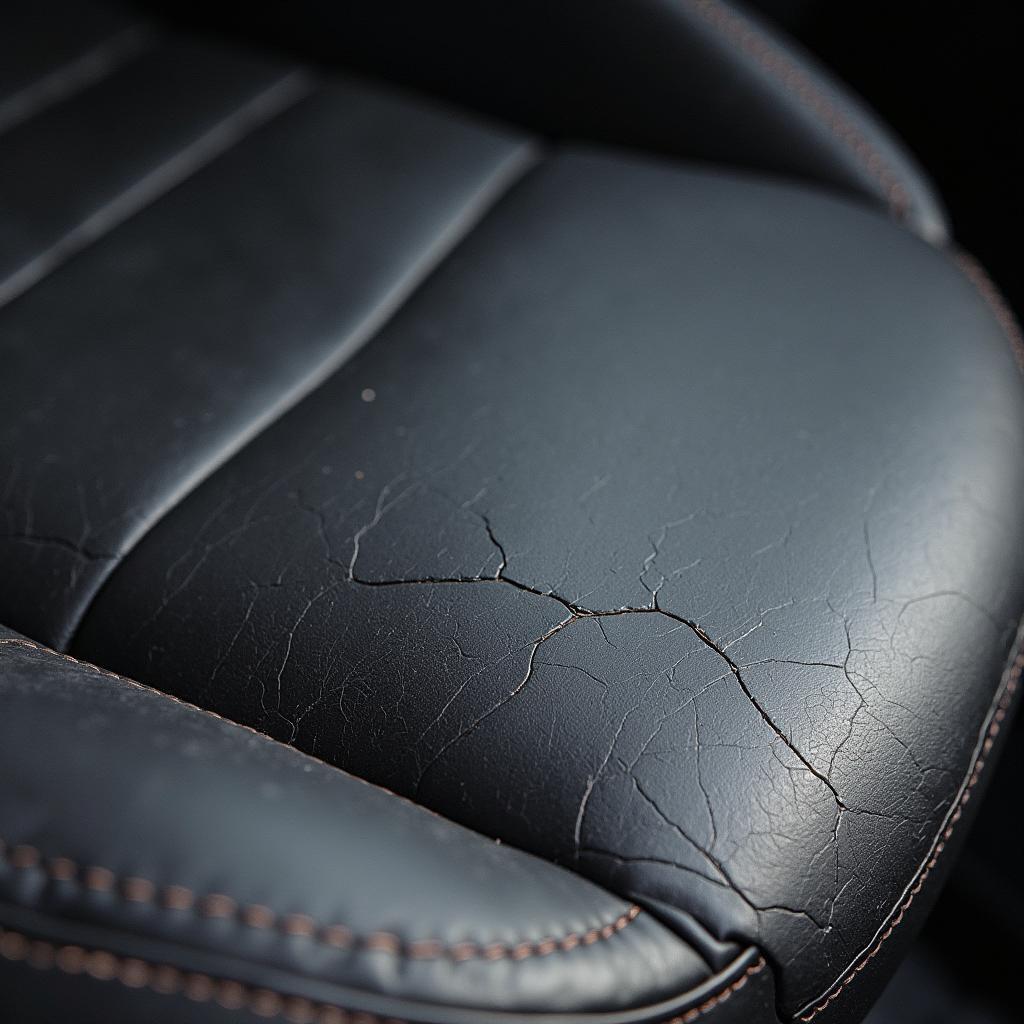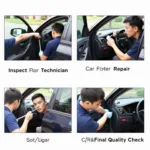Cracked leather car seats are an unsightly problem that can make your car’s interior look worn and dated. But don’t worry, repairing them yourself is easier than you might think. With a few simple tools and materials, you can have your seats looking like new in no time.
This comprehensive guide will walk you through the steps involved in repairing cracked leather car seats, so you can restore your car’s interior to its former glory and protect your investment.
Understanding Why Leather Seats Crack
Before we dive into the repair process, it’s helpful to understand why leather car seats crack in the first place. Here are a few common culprits:
- Sunlight exposure: Prolonged exposure to the sun’s UV rays can dry out leather, causing it to fade and crack over time.
- Heat: Similar to sunlight, excessive heat can also dehydrate leather, leading to cracks and damage.
- Lack of maintenance: Leather needs regular cleaning and conditioning to stay supple and prevent drying. Neglecting these tasks can make it more susceptible to cracking.
- Wear and tear: Frequent use, especially getting in and out of the car, can put stress on the leather, eventually leading to cracks in high-wear areas.
Assessing the Damage
The first step in repairing your cracked leather car seats is to assess the extent of the damage. Minor cracks can often be repaired with a simple leather filler or repair kit, while more severe damage may require professional attention.
Run your hand over the surface of the seat to feel for cracks, tears, and other imperfections. If the cracks are shallow and the leather is still relatively supple, a DIY repair is likely possible. However, if the leather is extremely dry, brittle, or has large holes, it’s best to consult with a professional upholsterer.
Gathering Your Materials
Once you’ve determined that a DIY repair is feasible, you’ll need to gather the necessary materials. Here’s a list of what you’ll need:
- Leather cleaner and conditioner: Choose a high-quality leather cleaner specifically designed for automotive leather.
- Leather filler or repair kit: Select a kit that matches the color of your car’s interior as closely as possible.
- Sandpaper: You’ll need sandpaper in various grits (e.g., 220, 400, 600) to smooth out the repaired areas.
- Masking tape: Use masking tape to protect areas around the damage during the repair process.
- Applicator tools: Most repair kits come with applicator tools, but you may also want to have some cotton swabs, small brushes, or sponges on hand.
- Clean cloths: Microfiber cloths are ideal for cleaning and buffing leather.
- Gloves: Wearing gloves will protect your hands from the chemicals in the leather cleaner and repair products.
Step-by-Step Guide to Repairing Cracked Leather Car Seats
Now that you have your materials ready, let’s dive into the step-by-step process of repairing your cracked leather car seats:
Step 1: Clean the Affected Area
Thoroughly clean the cracked leather with a leather cleaner and a soft cloth. Make sure to remove all dirt, grime, and debris from the cracks and surrounding area. This step is crucial for ensuring proper adhesion of the leather filler.
Step 2: Prepare the Cracks
Using fine-grit sandpaper (around 220 grit), gently sand down the edges of the cracks. This will help create a smooth surface for the leather filler to adhere to. Be careful not to sand too aggressively, as this can damage the surrounding leather.
Step 3: Apply the Leather Filler
Following the instructions on your chosen leather filler or repair kit, carefully apply the filler to the cracks. Use a small applicator tool to work the filler into the cracks, ensuring even coverage.
Step 4: Let it Dry
Allow the leather filler to dry completely. Drying time will vary depending on the product used, so refer to the manufacturer’s instructions.
Step 5: Sand and Smooth
Once the filler is dry, use progressively finer grits of sandpaper (400, then 600) to smooth out the repaired area. The goal is to create a seamless blend between the repaired area and the surrounding leather.
Step 6: Clean Again
After sanding, use a clean cloth to remove any dust or residue from the repaired area.
Step 7: Condition the Leather
Apply a high-quality leather conditioner to the entire seat, including the repaired area. This will help moisturize the leather and prevent future cracking.
Step 8: Buff and Enjoy
Using a clean microfiber cloth, buff the leather to a nice shine. Your cracked leather car seats should now look significantly better!
Can You Repair Cracked Leather Car Seats with Home Remedies?
While there are numerous home remedies touted for repairing cracked leather car seats, it’s important to approach these with caution. Some popular DIY solutions, like using olive oil or coconut oil, may temporarily mask the cracks but can actually do more harm than good in the long run. These oils can penetrate the leather and attract dirt, leading to discoloration and further damage over time.
For the best and most lasting results, it’s recommended to use products specifically designed for leather repair. These products are formulated to adhere properly to leather, provide durable repairs, and prevent further damage.
Preventing Future Cracks: Maintaining Your Leather Seats
Prevention is key when it comes to keeping your leather car seats looking their best. By incorporating a few simple maintenance practices into your routine, you can significantly prolong the life of your leather and prevent future cracking:
- Regular Cleaning: Clean your leather seats regularly using a pH-neutral leather cleaner and a soft cloth. Avoid harsh chemicals or abrasive cleaners, as these can damage the leather.
- Conditioning: Leather needs to be conditioned to stay supple and prevent drying. Use a dedicated leather conditioner every few months, or more often if your car is exposed to extreme temperatures or sunlight.
- UV Protection: Park your car in the shade whenever possible, or use a sunshade to protect the interior from harmful UV rays.
- Avoid Sharp Objects: Be mindful of sharp objects that could scratch or puncture the leather.
How Much Does It Cost to Repair Cracked Leather Car Seats Professionally?
If your leather car seats have extensive damage or you’re not comfortable attempting a DIY repair, it’s best to consult a professional upholsterer. The cost of professional repair can vary depending on the severity of the damage, the type of leather, and the location of the shop.
On average, you can expect to pay anywhere from [Provide a realistic price range for professional leather car seat repair in your region] for minor repairs, while more significant damage could cost upwards of [Provide a realistic price range for extensive leather car seat repair in your region].
When to Consider Professional Repair
While DIY repairs can be effective for minor cracks and damage, there are certain situations where professional intervention is the best course of action:
- Extensive Damage: If the cracks are deep, widespread, or accompanied by tears or holes, a professional upholsterer will have the expertise and tools to restore the seats properly.
- Valuable Leather: If your car has high-quality or rare leather upholstery, it’s best to entrust repairs to a professional to avoid the risk of further damage.
- Lack of Confidence: If you’re unsure about your ability to achieve a satisfactory repair, don’t hesitate to seek professional help.
Conclusion
Repairing cracked leather car seats is a manageable task that can significantly improve the appearance and value of your car’s interior. By following the steps outlined in this guide and practicing regular maintenance, you can keep your leather seats looking their best for years to come. And remember, if you’re ever unsure about a repair or dealing with extensive damage, don’t hesitate to consult a professional upholsterer for assistance.
For more helpful tips and guidance on car maintenance and repair, check out our other articles:
- How to Correctly Repair Damaged and Cracked Car Leather Seats
- How Much to Repair Cracked Leather Car Seats
Need expert advice or assistance with your car repair needs? Contact our team 24/7 via WhatsApp: +1(641)206-8880 or Email: [email protected]. We’re always here to help!


